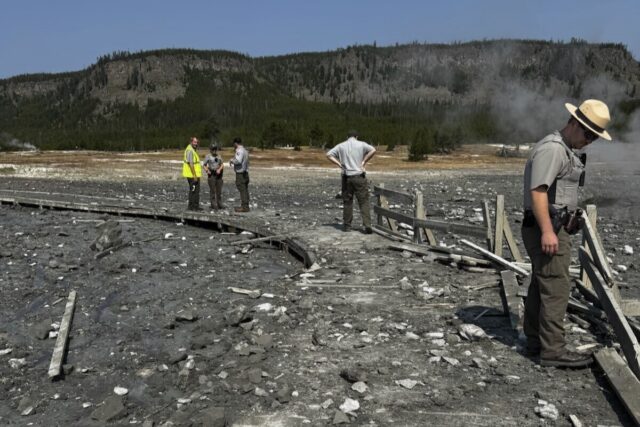A surprise eruption in Yellowstone National Park has shot steam, water and dark-colored rock and dirt an estimated 100 feet into the sky and sent people running for safety
Surprise blast of rock, water and steam in Yellowstone sends dozens running for safetyBy MEAD GRUVER, AMY BETH HANSON and MATTHEW BROWNAssociated PressThe Associated PressCHEYENNE, Wyo.
CHEYENNE, Wyo. (AP) — A surprise eruption in Yellowstone National Park shot steam, water and dark-colored rock and dirt high into the sky Tuesday and sent sightseers running for safety.
The hydrothermal explosion happened around 10 a.m. in Biscuit Basin, a collection of hot springs a couple miles north of the famous Old Faithful Geyser.
Video posted online showed a couple dozen people watching from a boardwalk as the eruption sprayed and grew in front of them. As water and debris began to fall, they ran to keep clear, some yelling “Back up!” and “Holy cow!” People then turned to watch the spectacle under a huge cloud of steam.
No injuries were reported but the eruption damaged the boardwalk, an elevated wooden walkway that keeps people off Yellowstone’s fragile and often dangerous geothermal areas. Photos and video of the aftermath showed damaged guardrails and boards covered in rock and silt near muddy pools.
No injuries were reported, but the Biscuit Basin area was closed for visitor safety.
The explosion could have resulted from a clogged passageway in the extensive natural plumbing network that underlies Yellowstone’s world-famous geysers, hot springs and other thermal features, said scientist Mike Poland with the Yellowstone Volcano Observatory.
A clog would have caused a buildup of heat and pressure such as happens inside a pressure cooker, he said, until the water suddenly flashed to steam, causing an instantaneous and huge expansion in volume and triggering the explosion.
After viewing video from the event Poland estimated that the explosion sent material about 100 feet (30 meters) into the air.
He said the explosion was “on the big side” of eruptions that occur periodically — usually when no one is around let alone throngs of tourists.
On occasion they get much bigger: The largest known crater from a hydrothermal explosion on Earth is in Yellowstone and measures 1.5 miles (2.4 kilometers) across, Poland said. Scientists theorize that a series of hydrothermal explosions created that crater some 13,800 years ago in the Mary Bay area on the northeastern side of Yellowstone Lake.
By comparison, the crater from Tuesday’s explosion will likely be measured in feet, Poland said.
“What we saw today was spectacular and definitely hazardous. But on the scale of what the Yellowstone system has done in the past, it was relatively small,” he said. “It’s a very good reminder of an underappreciated hazard in Yellowstone.”
The explosion happened in or near Black Diamond Pool, a 120-foot-log (37-meter-long) hot pool that is the basin’s widest thermal feature.
A National Park Service aerial photo taken afterward showed the pool somewhat enlarged near the boardwalk compared to recent satellite images and its water turned a muddy beige. The deep Sapphire Pool about 100 yards (91 meters) away retained its usual blue hues.
Park geologists were investigating what specifically happened in this case.
Similar blasts have happened in Biscuit Basin in 2009, 1991 and after the magnitude 7.2 Hebgen Lake earthquake 40 miles (64 kilometers) away in 1959.
Yellowstone is centered on a huge, dormant volcano. The hydrothermal explosion did not indicate new activity within the volcanic system, which remains at normal levels, according to the U.S. Geological Survey.
At least 22 people are known to have died from injuries related to thermal features in and around the 3,471-square-mile (9,000-square-kilometer) national park since 1890.
Visitors are warned to stay on the boardwalks and trails in thermal areas, where some of the pools and springs have a thin, breakable crust covering the scalding and sometimes acidic water.
___
Hanson reported from Helena, Montana, and Brown reported from Billings, Montana.

COMMENTS
Please let us know if you're having issues with commenting.